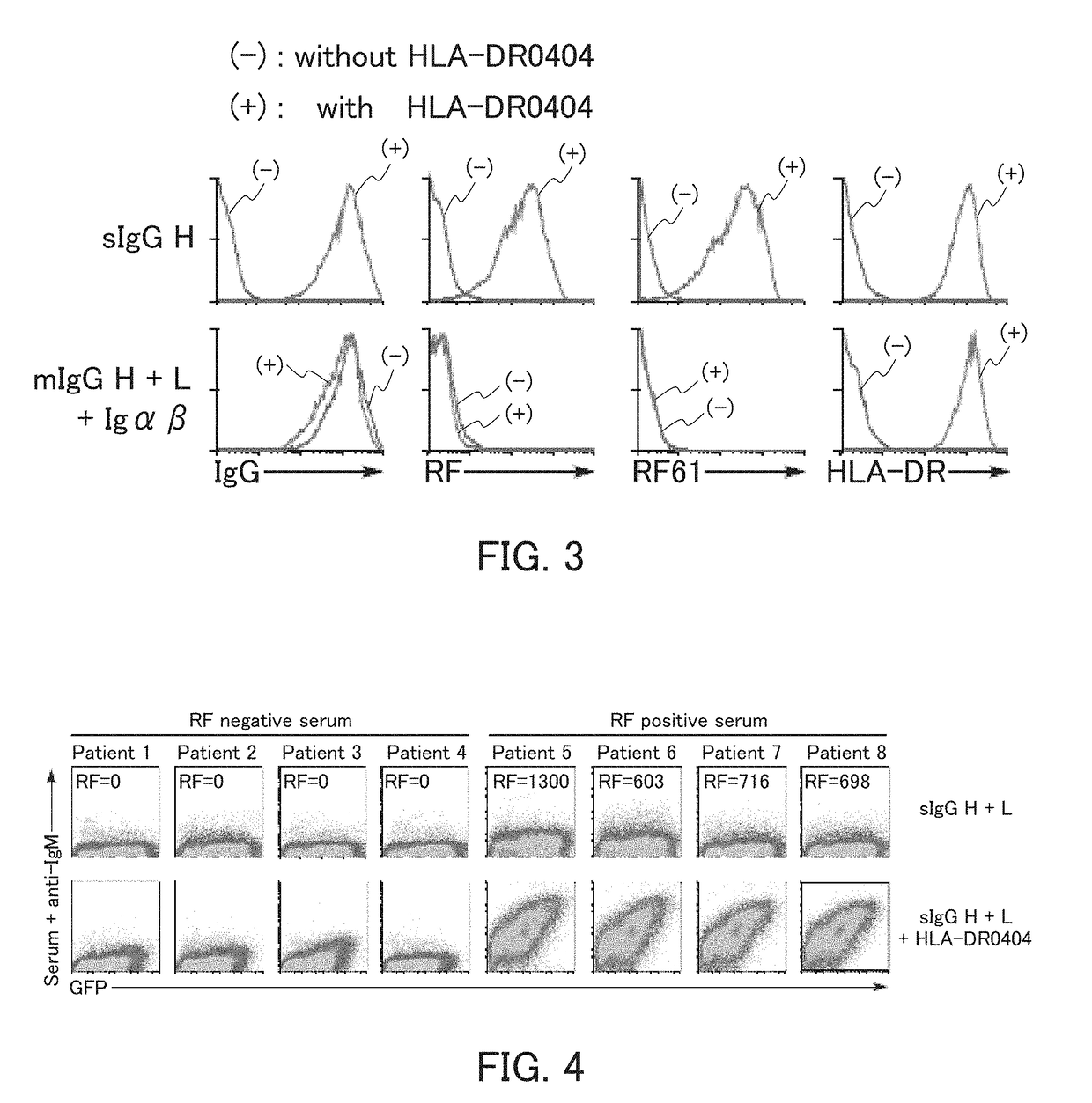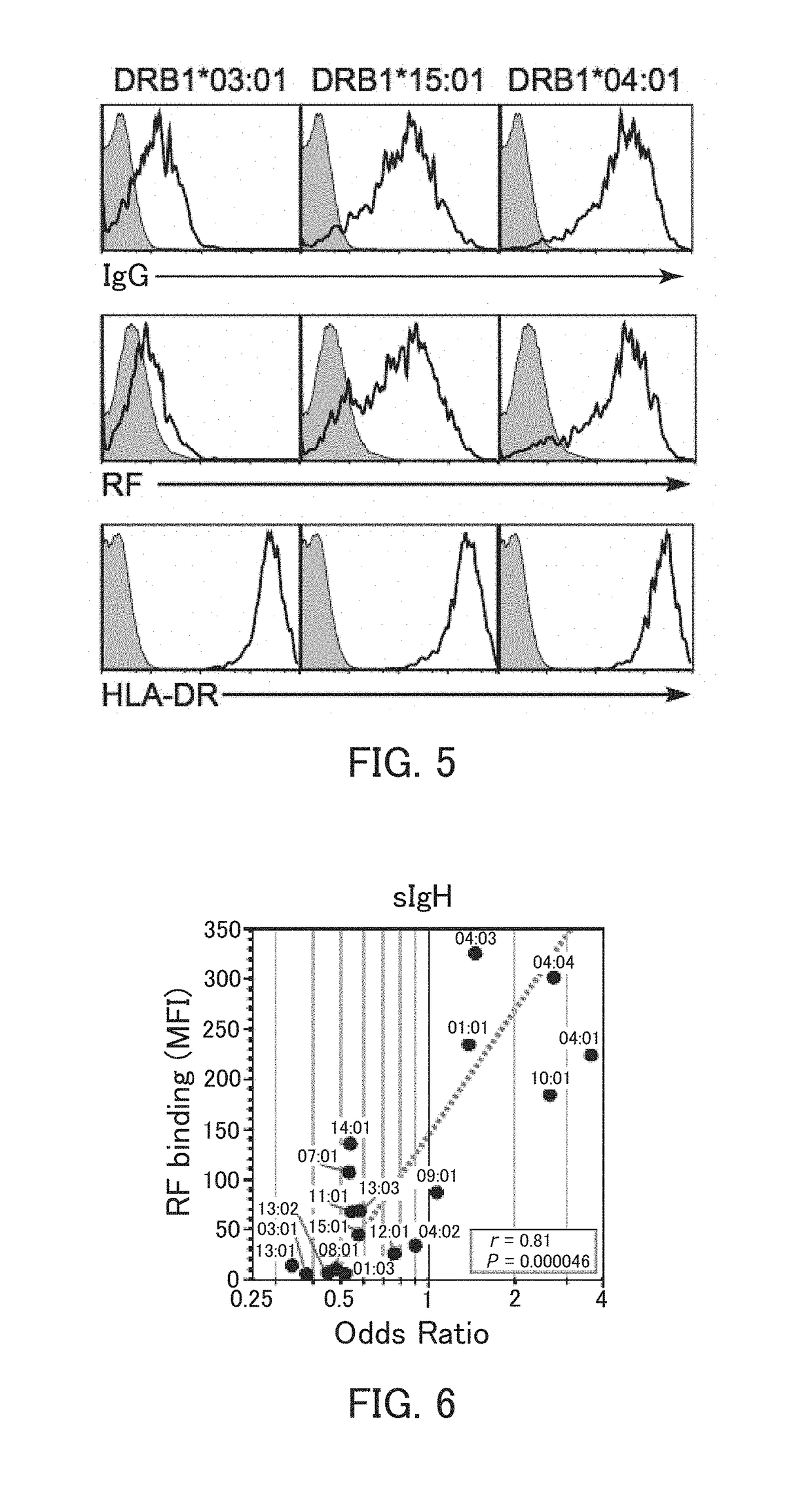Autoantibody detection method, method for testing possibility of autoimmune disease contraction, autoantibody detection reagent, and autoimmune disease test reagent
a technology for autoantibody detection and autoimmune diseases, applied in the field of autoantibody, can solve the problems of false negative results and inability to detect autoantibody in all patients, and achieve the effects of high specificity, high accuracy and high accuracy
- Summary
- Abstract
- Description
- Claims
- Application Information
AI Technical Summary
Benefits of technology
Problems solved by technology
Method used
Image
Examples
example 1
[0136]Example 1 relates to the detection of an autoantibody as an indicator of rheumatoid arthritis.
example 1a
[0137]In the present example, HLA-DR and an IgG heavy chain were expressed, and whether the IgG heavy chain was presented on cell surfaces by the HLA-DR was examined.
[0138]The HLA-DRA*01:01 vector as an α-chain expression vector, the HLA-DRB1*04:04 vector as a β-chain expression vector, the sIgGH vector for secretory IgG heavy chain expression, and the GFP vector were introduced to 293T cells, and the 293T cells were cultured. The cultured cells were reacted with an allophycocyanin (APC)-labeled anti-human IgG Fc antibody or anti-HLA-DR antibody, and further reacted with an APC-labeled anti-mouse IgG antibody. Thereafter, the cells were subjected to flow cytometry analysis. Specifically, using a flow cytometer (trade name; FACS Calibur™, Becton Dickinson), IgG heavy chain expression and HLA-DR expression on surfaces of GFP-positive cells were examined. As Control 1, the analysis was performed in the same manner, except that the HLA-DR expression vectors were not introduced. As Contr...
example 1b
[0143]In the present example, HLA-DR was immunoprecipitated, and whether an IgG heavy chain was bound to the peptide-binding groove of the HLA-DR was examined.
[0144]To 293T cells, the HLA-DRA*01:01 as an α-chain expression vector and the other respective expression vectors were introduced so as to achieve the combinations shown in FIG. 2 to be described below. The 293T cells were then cultured. The cultured cells were lysed in a 0.5% NP-40 solution (polyoxyethylene(9)octyiphenyl ether), and the resultant cell lysate was immunoprecipitated using a biotinylated anti-HLA-DR antibody and streptavidin sepharose (GE Healthcare).[0145]biotinylated anti-HLA-DR antibody for immunoprecipitation: Clone L243, available from ATCC, mAb
[0146]Western blotting was performed on the immunoprecipitated sample. Specifically, the sample was applied to electrophoresis, and IgG and HLA-DR were detected using a peroxidase-labeled anti-human IgG antibody or a rabbit anti-HLA-DR a antibody and a peroxidase-la...
PUM
| Property | Measurement | Unit |
|---|---|---|
| temperature | aaaaa | aaaaa |
| temperature | aaaaa | aaaaa |
| temperature | aaaaa | aaaaa |
Abstract
Description
Claims
Application Information
 Login to View More
Login to View More - R&D
- Intellectual Property
- Life Sciences
- Materials
- Tech Scout
- Unparalleled Data Quality
- Higher Quality Content
- 60% Fewer Hallucinations
Browse by: Latest US Patents, China's latest patents, Technical Efficacy Thesaurus, Application Domain, Technology Topic, Popular Technical Reports.
© 2025 PatSnap. All rights reserved.Legal|Privacy policy|Modern Slavery Act Transparency Statement|Sitemap|About US| Contact US: help@patsnap.com



